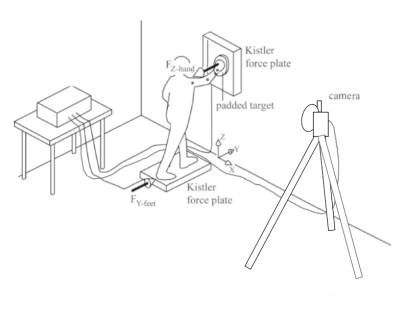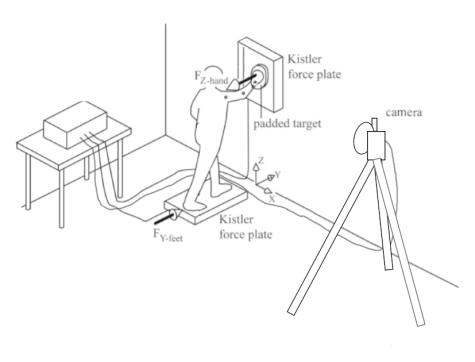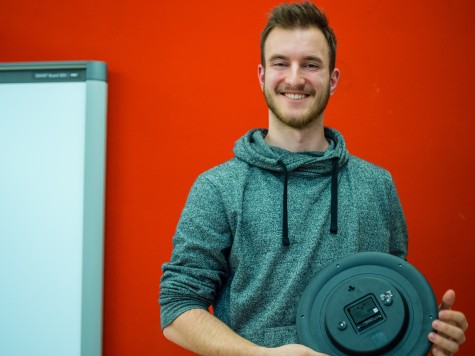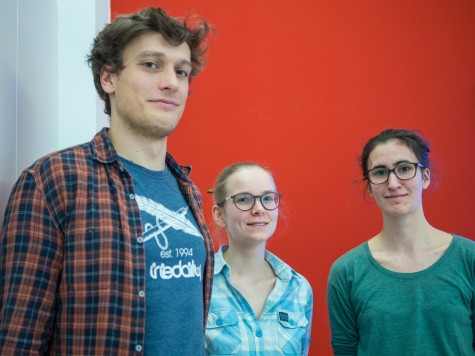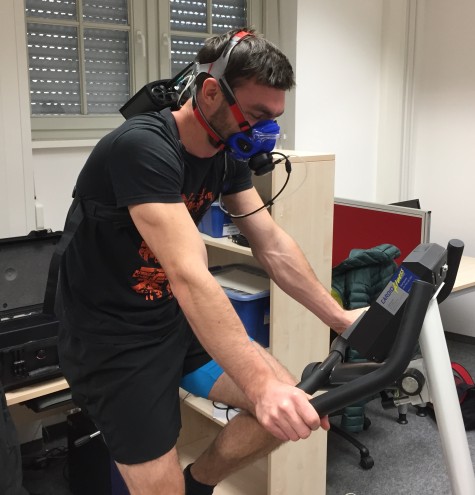| Coursename | Einführung in die biomechanische Bewegungserfassung und -analyse |
| Course number in TuCan | 03-41-0580-se |
| Type | Seminar with practical tutorials |
| Credits | 5 CP |
| Offered | every winter semester |
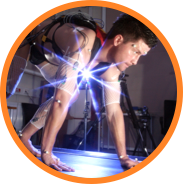
This module aims to teach students about
- equipment and methods of data collection in biomechanics
- data processing and analysis using Matlab.
Starting with an introduction to Matlab, this course covers the basics of data processing and manipulation in a biomechanics context. Optimization techniques and simple statistical analyseswill also be covered.
A large part of the course will consist of lab demos and student-based exercises and data collections. This will allow students direct hands-on experience with various measurement systems (e.g., force plates, motion capture, electromyography etc.). Students can reflect on learnedtechniques and their limitations through optimization and statistical analyses of the data collected.
Previous Projects
APRIL 2019
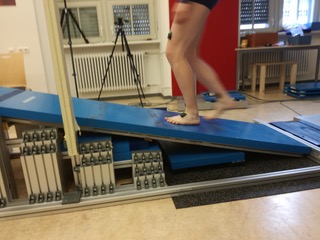
Lukas Nevermann, Martin Steil, Alexandru Trifan:
Distinguishing features in walking on different surfaces – Climbing stairs vs. walking on a slope
In this project our goal was to find features to distinguish between climbing a slope and climbing stairs. The idea was to find something which could be used to control an active lower limb prosthesis, for example an ankle prosthesis. Therefore we investigated the behavior of the shank and thigh angle as well as the angular velocity.
Clara Will, Daniel Maninger, Thomas Kampa:
Untersuchung der Effektivität der Korkenziehertechnik
In vielen unterschiedlichen Kampfsportarten gehört der Fauststoß zum Technikrepertoire. Es wird zumeist empfohlen, die Faust während des Schlags in eine horizontale Position zu drehen. Für diese sogenannte Korkenziehertechnik gibt es verschiedenste Begründungen, jedoch keine wissenschaftliche Erklärung. In unserer Untersuchung überprüfen wir die Effektivität hinsichtlich einer größeren aufbringbaren Kraft durch einen höheren Körpereinsatz oder eine höhere Geschwindigkeit. Zusätzliche Vorteile, wie einen höheren Schutz des Kämpfers und eine größere Antrittsgeschwindigkeit, werden auch betrachtet.
Vier Kampfsportler führen jeweils drei Sets á 10 Schlägen sowohl mit der Korkenziehertechnik und als auch mit einer Technik ohne Rotation der Hand aus. Mit Hilfe einer vertikalen Kraftmessplatte, die als Zielfläche für den Fauststoß dient, einer horizontalen Kraftmessplatte, auf der der Proband positioniert ist, und einem Motion Capture System, werden Kraftdaten, Drehmoment und Positionsdaten gemessen (siehe Abbildung). Aus den ermittelten Daten wird ein Impulsverhältnis bestimmt, dass auf den Trainingsstand rückschließen lässt und die maximale Kraft normal und tangential zur vertikalen Kraftmessplatte betrachtet. Aus den Positionsdaten lassen sich die Position von Schulter und Ellenbogen während dem Treffer, Geschwindigkeit kurz vor dem Treffer und Beschleunigung zu Beginn der Bewegung bestimmen.
Die maximalen Kräfte, sowohl normal als auch tangential zur Kraftmessplatte, sind signifikant höher mit Rotation der Faust als ohne Rotation. Das Impulsverhältnis ist jedoch bei Anwendung der Korkenziehertechnik signifikant geringer. Da dies als ein Nachweis für einen hohen Körpereinsatz gesehen wird, kann die erhöhte Kraft nicht aus einem erhöhten Körpereinsatz resultieren. Dies belegen auch weitere Daten, wie das Drehmoment, welches sich zwischen den Techniken nicht unterscheiden. Stattdessen ist die Geschwindigkeit vor dem Treffer signifikant höher mit Rotation der Faust und kann somit als eine mögliche Erklärung für die gesteigerte Kraft angesehen werden. Die Korkenziehertechnik bietet dem Sportler keinen Vorteil in Form einer höheren Antrittsgeschwindigkeit zu Beginn der Bewegung. Jedoch ist die Position der Schulter und des Ellenbogens signifikant höher unter Einsatz der Korkenziehertechnik und bietet somit dem Kämpfer eine bessere Deckung während dem Schlag gegen Konterangriffe.
Insofern kann aus dieser Untersuchung geschlossen werden, dass die Korkenziehertechnik bezüglich der maximalen aufzubringenden Kraft effektiver ist. Die Gründe liegen in der höheren Geschwindigkeit und können hier nicht durch einen besseren Körpereinsatz belegt werden. Zusätzlich bietet die Korkenziehertechnik einen besseren Schutz für den Kampfsportler. Für zukünftige Studien ist es interessant, die muskuläre Aktivität der beiden Techniken mithilfe von Elektromyographie (EMG) zu vergleichen, um so auf eine bessere intramuskuläre Koordination schließen zu können.
APRIL 2018
Tabea Wilke, Connor Sachs, Lucas Bobzien:
Walking variability while carrying a coffee mug
In this Project we wanted to investigate how gait techniques changed in unfocused walking or when focusing on the mug. The goal of analysis was to determine differences to natural walking and how one efficiently transports a cup of hot beverage over a defined distance. In this context efficiency means that the route should be completed as quickly as possible without spilling the liquid.
Felix Staniek:
Analysis of movement patterns in disc throws – with a focus on static and dynamic upper body kinetics
The goal of this experiment was to investigate whether there are differences between a freely standing backhand throw and the backhand throw with a shoulder fixation (bar underneath the armpit). To test this, the movement precision of the arm including the joint angles and the total angle of horizontal abduction was investigated.
Frank Buttgenbach, Andreas Jentsch, Eike Metzendorf:
Vertical jumping in Volleyball, Hockey and Fencing
The main goal of this study is to characterize differences in vertical jumping technique between athletes in Volleyball, Hockey and Fencing. Conclusions are drawn using leg stiffness, contact time and hight of jump as parameters. The leg stiffness was calculated using a commonly used nonlinear spring model.
Ida Blum, Klara Saary, Matti Moeller:
Influences of vibrating insoles on muscle activity
In this study, it is to investigate whether vibrations under the plantar sole lead to above average muscle activation or even cramping in lower limb muscles.
APRIL 2017
Jan Scheibe:
Functional Electrostimulation effects on antagonistic muscle group
Functional electrostimulation (FES) offers a way of creating movement in limbs whose functional motor innervation is no longer given. In this project, the effects of functional electrostimulation on an antagonistic muscle group, that is not to be stimulated, is observed. As setup, the biceps brachii is stimulated by FES, and triceps brachii lateral head as its antagonist is monitored by EMG. After noise and setup interferences were removed out of the signal, yet a significant activation of the triceps is recorded. This indicates a co-contraction induced by the FES, resulting in possible lower maximal forces and a faster muscle fatigue when applied.
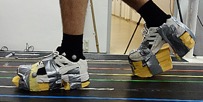
Victorio Lato:
Influences of Varying Leg Length Discrepancy on Gait Trajectories for Normal Walking
This project aims to contribute to the process of determining what amount of LLD is significant to cause changes in gait trajectories by measuring trajectories of a subject with different artificial amounts of LLD. The vertical position of the center of mass, leg circumduction, the hip angle, the knee angle, the ankle angle, the angle of calcaneal eversion, the angle of plantarflexion and dorsiflexion, the step length, step time and step speed and the vertical ground reaction force were taken into account.These measured variables have been measured for 3 minutes after 2 minutes of training for normal and extendable shoes with 0, 2, 4 and 6 cm LLD for one subject. Different effects and strategies of compensation have been examined even though not all expected effects have been observed. The most significant strategy was bending the knee of the longer leg in stance. Furthermore, the subject showed decreased plantarflexion and increased calcaneal eversion on the longer leg to compensate the sole extension. All three strategies occurred for all measured LLDs and increased with increasing LLD. Another expected effect was a greater amplitude of the vertical center of mass. This was obtained for 4 and 6 cm LLD and not for 2 cm. Thus, changes in the amplitude of the center of mass require a LLD of more than 2 and less than 4 cm.
David Dahlem:
Influence of walking poles on the knee joint load when carrying a backpack on level walking
In this project the question if hiking poles can influence the knee joint load on level walking while carrying a heavy backpack is addressed. Methods: One subject with a backpack of 25kg is tested on three different conditions while walking on a treadmill: Walking without hiking poles (C1), walking with hiking poles (C2) and walking with hiking poles while putting an extra high load onto them (C3). Marker data of the lower limbs, force data of the force plates under the treadmill and force data of one hiking pole is measured. With this data and an inverse kinematic approach vertical knee force and knee torque is calculated. Results: On C2 and C3 the trunk is more leaned forward compared to C1. The maximum average knee torque from C2 reduces to 81% to the one of C1. Vertical knee forces are only slightly changing for C2.
James Murphy, Andrej Scherf:
Influence of the saddle height on the metabolic cost during cycling
This study aims to measure the influence of saddle height during cycling on the metabolic costs of two male test persons between the ages of 25 and 29. Experiments involved a 20 minute cycle at a constant submaximal power output and a constant cadence of 80 RPM. The metabolic costs at the optimal saddle height as described using the Hamley method (Hamley, 1967) (109% of inseam leg length) were compared with saddle heights in a lowered position (104% of inseam leg length) and in a raised saddle position (114% of inseam leg length).The results showed no significant influence on the metabolic costs from the saddle height in both test persons although this could be due to the influence of secondary mechanisms that could not be accounted for in the small sample group used in this study. Further tests would have to be carried out to gauge the influence of these secondary mechanisms and to explicitly investigate the influence of saddle height on metabolic costs.
Christian Kubik, Simon Dwucet:
The influence of dropping height on the maximal vertical height of the drop jump
This study provides a small analysis about the influence of drop height on the vertical jump height.Two recent studies had different results and statements about the correlation between drop height and jump height. From recent studies it is known that muscles can absorb energy in form of elastic energy. To understand why the papers had different results drop jumps were measured and analyzed. Three different heights were used and compared to the jump height without a preceded drop as a reference. 4 Cameras and a force plate were used to measure the reaction of dropping from heights of 0.15 , 0.3 and 0,4. The maximum vertical jump height in correlation with drop height showed that the higher the drop is the higher is also the jumping height. This confirmed the hypothesis of stored energy in muscles and tendons. Furthermore the work was calculated for the movement. This was separated into work down and up. Work down is the energy which is absorbed into the system. And the work up is the work needed to reach the highest jumping point. The efficiency of muscle storing elastic energy was calculated and showed that it is really low but had the same values as one of the studies. By analyzing the data, large differences between the two subjects were spotted. Further researches showed that the subjects had different jump techniques therefore the results are not significant.


